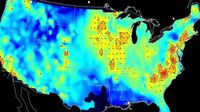A strong solar storm headed toward Earth could make the northern lights visible across the northern United States this week, space weather forecasters say. The National Oceanic and Atmospheric Administration’s Space Weather Prediction Center issued a geomagnetic storm watch following recent explosions on the sun, which triggered multiple “coronal mass ejections” that left the sun on Sunday, April 13, 2025, and were expected to reach the Earth beginning Wednesday, April 16, 2025.
A coronal mass ejection, or CME, is an eruption of solar material and magnetic fields, according to NOAA. When they reach Earth, it can result in a geomagnetic storm, producing colorful auroras, also known as northern lights. How strong is this solar storm? Their strength depends on how Earth’s magnetic field interacts with the solar bursts. The watch issued for Wednesday was a 3 out of 5 on the geomagnetic storm severity scale.
G3 storm conditions may cause minor disruptions to satellite, radio, and GPS communications, NOAA said. But more importantly for sky-gazers, they may make auroras visible as far south as northern Iowa and Oregon. According to NOAA’s Aurora Viewline Forecast, northern lights may be visible in more than a dozen states on Wednesday, including Alaska, Washington, Oregon, Montana, North Dakota, South Dakota, Minnesota, Michigan, Wisconsin, Vermont, New Hampshire, and Maine. They may also be visible in parts of Idaho, Wyoming, Nebraska, Iowa, and New York.
Exactly when they’ll be visible is also dependent on the level of geomagnetic activity, but the best time for viewing them is usually within an hour of midnight, NOAA says. And if you aren’t able to see the northern lights this week, you’ll have plenty more opportunities this year. That’s because the sun is at the peak of an 11-year magnetic activity cycle, or its "solar maximum" period, making auroras more common and widespread.
“This is going to kind of continue off and on throughout the year,” NOAA space weather forecaster Shawn Dahl told the Associated Press. A massive solar storm due to hit Earth today, April 16, 2025, could cause radio blackouts and power grid disruptions. Officials are tracking a powerful burst of solar plasma and magnetic fields, which made impact Tuesday, April 15, 2025, and continues to affect our planet.
The G3 geomagnetic storm could interfere with power grid operations in the Mid-Atlantic, Northeast, and Midwest regions of the US. It may also lead to GPS outages, satellite malfunctions, and other system disruptions. Dr. Tamitha Skov, an independent space weather physicist, told DailyMail.com that if the storm persists for another 10 hours, power outages could occur.
Scientists have also predicted that the event will produce colorful aurora displays in 19 states. Northern lights are forecasted as low as New York to Wisconsin to Washington state. Northern lights have been forecasted in Alaska, Washington, Oregon, Montana, North Dakota, South Dakota, Minnesota, Michigan, Wisconsin, Vermont, New Hampshire, and Maine. Parts of northern Idaho, Wyoming, Nebraska, Iowa, Illinois, New York, and Pennsylvania may also get a view.
The best time to see the colorful lights is between 10 PM and 2 AM local time. To see the spectacle, wait for clear skies to get dark and then go outside, ideally away from bright city lights. Taking a picture with a smartphone camera may also reveal hints of the aurora that aren’t visible to the naked eye.
The coronal mass ejection (CME) hit Tuesday, April 15, 2025, triggering northern lights in the upper northern hemisphere and a moderate 'G2' level geomagnetic storming overnight, which was upgraded to G3 today, April 16, 2025. A G3 geomagnetic storm can cause minor disruptions to radio and satellite communications, potentially leading to a few hours of lost radio contact, according to NOAA.
Power grid fluctuations can occur. High-latitude power systems may experience voltage alarms, SPWC shared in the alert. The SWPC predicts a high risk in electrical grid disruptions in the Mid-Atlantic and Northeastern, especially Virginia, Pennsylvania, and New Jersey, US. Parts of the Midwest, like Minnesota and the Dakotas, also show elevated activity.
The last Geomagnetic Storm Warning was issued in October 2024 over a G4 storm set to hit Earth. There were concerns about potential disruptions to power grids, especially in areas already weakened by recent hurricanes that hit Florida and North Carolina. While no widespread outages were reported, utilities were on high alert for voltage control issues.
Blackouts and power grid disruptions could follow a massive solar storm after it hit the Earth this week, but only if it rages for long enough. Waves of energy ejected from the Sun were seen hitting the Earth late on Tuesday, April 15, 2025. The NOAA earlier warned that people may expect "limited, minor effects" on technological infrastructure, adding any issues would likely be "mitigable".
Independent space weather physicist Dr. Tamitha Skov has emphasized the real risk this G3 solar storm poses. While millions may gaze up at the skies between 10 PM and 2 AM hoping to witness the Northern Lights in areas far outside the Arctic Circle, power grid operators and aviation safety authorities are on high alert.
“The key is the length of the G3,” Dr. Skov explained. “If this geomagnetic storm continues at a high intensity for an extended period, we could see widespread blackouts and satellite communication failures—especially across North America, where grid systems are particularly vulnerable.”
Grid operators across the United States and Canada are monitoring for voltage irregularities and geomagnetically induced currents (GICs) that can damage transformers, satellites, and navigation systems—especially those used by airlines and cruise ships. Commercial airlines, particularly those operating polar or transatlantic routes, are especially susceptible to geomagnetic interference.
Navigation and communication systems on aircraft rely on satellite signals that can be degraded during solar storms. Flights over high-latitude regions—including routes from New York to Tokyo, Chicago to Beijing, and even domestic paths to Alaska—are at heightened risk. Airlines like Delta, United, and Air Canada have already been advised to alter flight paths if the solar storm continues beyond its predicted window.
While no major reroutes have been publicly announced, several airline spokespersons confirmed to travel media that operations teams are in "constant contact" with aviation meteorologists and space weather centers. Travelers flying during this period, especially overnight or early morning flights over Northern regions, are advised to check with their carriers for potential delays or reroutes.
Airports in Minneapolis, Calgary, Seattle, and even parts of the Midwest could face disruptions if navigation systems encounter interference. It’s not just air travel feeling the heat of the Sun’s wrath. Modern tourism infrastructure, including booking platforms, airport check-in systems, and credit card processing technologies, rely heavily on GPS and satellite connectivity.
A significant geomagnetic event could freeze transaction systems, delay luggage scanning technologies, and disrupt digital gate access protocols. Cruise ships traveling near polar regions, such as those en route to Iceland, Norway, or Alaska, may also be impacted. Areas as far as Kentucky, Michigan, and Upstate New York have reported sightings of the Northern Lights.
The epicenter of travel-related concerns lies in the Northern United States and Southern Canada, where the geomagnetic latitude makes grids more susceptible to solar storms. Power companies in Minnesota, Ontario, North Dakota, and Quebec have been advised to prepare for potential transformer overloads and voltage drops. This week’s G3 event has also ignited a frenzy of aurora tourism.







